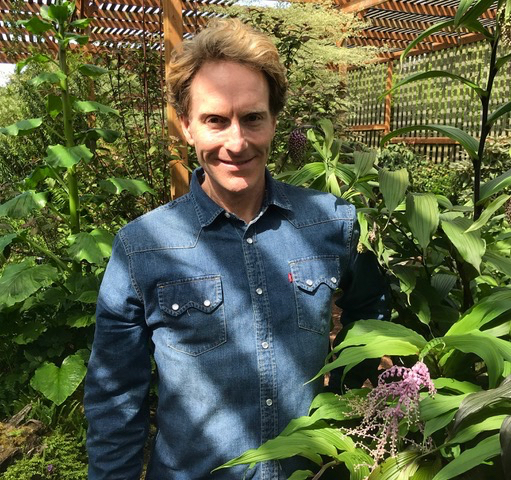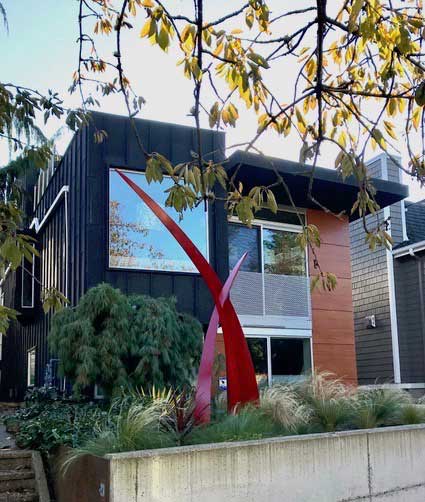APLDWA Featured Designer:
Michael Muro
Designer and Owner of MMGD
Member since 2016
This quarter, Michael Muro tells us his story—from mowing neighborhood lawns in grade school to designing gardens that support the arts.

Michael Muro, designer, and owner of MMGD. All Photos: Michael Muro
When did you start designing gardens? Tell us about your path from then to now.
I sometimes wonder if the love of horticulture is hereditary. My mother was an avid gardener, as was her mother. And, my great-grandparents on my mother’s side were wheat farmers in eastern Washington. I was always intrigued by my mother’s story of riding in the carriage that fed the field hands during harvest time.
I have been passionate about horticulture and design from a young age. While I think part of it is in my genes, I was fortunate that my family somehow appreciated this passion early on. It started with projects at my childhood family home and eventually grew into a business. I mowed lawns and weeded gardens for neighbors as far back as grade school. In junior high, I grew kinnikinnick plants from cuttings and sold them to gardening customers. I was always more interested in working in the yard after school than doing my homework. On weekends I would be in the garden until my mother called me in for dinner.
My first true design project was the entry garden at my parent’s home. Even though I was only a young teenager, my mother trusted the project to me. I was fortunate that the family house was a beautiful property, and it showcased this project. Neighbors asked for referrals, and suddenly the shift happened from being a neighborhood teenager doing gardening to the beginning of a design portfolio.

The clean lines and expansive walls of a stately Capitol Hill home make an ideal backdrop to showcase plantings. Container gardens provide a human scale, and complement the dramatic neoclassical architecture creating a welcoming entrance and maximizing curb appeal.
I attended the landscape architecture program at the University of Oregon. I opted out of the more mechanical side of the program, knowing I wasn’t suited to this side of the trade. I continued to focus on the creative side through other college and continuing education programs.
My professional career launched at a commercial landscape company managing the interior plant and color rotations for a major developer. I also spent ten years in outside sales and marketing for landscape and design firms, building a client base and a diverse portfolio of projects. After working for several companies, I decided to make a change and enrolled at South Seattle Community College to refresh and update my knowledge. I started my own business in 2001, combining my love of landscape design and my interest in business and finance. Since then, I have spent my time listening to my clients, encouraging their own creativity, and developing concepts for outdoor spaces that work for their lifestyle.

A combination of perennial and evergreen plants ensures that this garden has no down time. Evergreen shrubs provide privacy and screen unwanted views, creating a rich backdrop for seasonal blooms at this Ballard bungalow in Seattle, WA.
Who inspires your designs?
While I find inspiration from many people, places, and things, if I had to choose one person, it would be Leonardo da Vinci. His work is always beautiful, based on meticulous mathematical symmetry combined with his highly developed sense of aesthetic. For me, this is the fundamental of landscape design. Like a landscape, da Vinci's work is a sum of its parts—from the technical to the aesthetic. But in the end, inspiration is fluid.

The industrial look of an unfinished cement retaining wall and a simple sculpture enhance the architecture and create a synergy between the house and garden. A large weeping pine grounds the structure, and a simple mass planting of grasses is a unifying feature with a casual air.
Tell us about one of your favorite or most memorable projects.
A project is memorable when the client is engaged and excited by the prospects, especially if they bring ideas of their own to the vision and concept phase. The best projects are usually collaborative in nature—including the client, other designers, and technical experts. Three of my favorites include a residential project in Port Townsend, an isolated retreat on Hat Island, and the LaSalle Reserve on Maury Island.
Residence at Rosewind, Port Townsend, WA:
The goal of the project was to create a landscape for a small home in a co-housing community. The owner had specific preferences, including
Asian-inspired design and the use of natural, local materials. The client also wanted a low maintenance garden and to avoid supplemental watering to the extent possible.
The site conditions and the client's interests led to a laser-focused plant list that I would not have otherwise imagined. The design included plants that would thrive in poor and rocky soil, and survive a population of voracious deer that grazed the property daily. Rock was collected from the site to build retaining walls and for use as landscape features. The patio was made from flagstone, and informal pathways were made of crushed rock.
The result had the look of simplicity, but in reality, it was complex to design and install. The success was in the creative adaptation of the client’s interests and the site conditions.
Modern Retreat, Hat Island, WA:
Starting off this project, there was no commercial ferry service to the island, and the private ferry had just fired its skipper. Sailing across on
a small boat was the kick-off to the project.
The home had a modernistic style and was situated on a large, secluded lot atop a knoll with expansive views of the water. It was an opportunity to work in concert with the natural surroundings. In front of the house, I suggested flanking a loosely mowed central corridor with large swaths of perennials and grasses to create drifts and define the contours, creating visual layers leading the eye outward. On the other side of the house, the exposure lent itself to woodland plantings. A winding stone path leads from the parking area at the edge of the woods, on to a clearing and then eventually to the home's front entrance. Organic-shaped swaths of similar plants created a lush, leafy texture in many shades of green, with various plants blooming throughout the spring and summer.
I had a ‘sixth sense’ about this project, which unfolded when I complimented the clients on their art collection. The owner replied, “Oh, those are pieces that my father didn’t sell. He wasn’t well known—you wouldn’t know him.” But it turned out that I actually did. He was part of a modernist movement in Seattle. His works included a promotional series commissioned for the 1962 World’s Fair in Seattle—a piece that held a prominent position in my home of the same era. That was a wonderful moment.
Over the course of the project, I learned about the unusual charm of living on Hat Island, including the lack of any predictable means of returning to the mainland. A stunning project that took me back to an epic time.

‘Aphrodite Asparagus’ (a.k.a. ‘Our Lady of the Asparagus’) is surrounded by a rich palette of perennials at the LaSalle reserve, Maury Island, WA.
The Sculpture Garden, The LaSalle Reserve, Maury Island WA
There were actually several projects on this site, but the immediate project was to design gardens around a whimsical sculpture designed by the owner. The sculpture, where a hidden goddess peers out from a giant asparagus, was one of several prominent installations on the site. Designing a perennial garden to highlight the sculpture was the goal, but it also needed to align with a long-term renovation and expansion plan for the entire property.
It was an opportunity to work on a large-scale design with a European influence. The original landscape plan was reminiscent of the Italian countryside. It included an expansive mortar-set flagstone patio, a reflecting pool, a small lake and waterfall. Some plantings enhanced the art installations, while others gave structure to the grounds and supported stunning views of a hillside vineyard, Puget Sound, and the fantastical art on the property. I went on to design two additional gardens that surrounded other sculptures designed by the owner.
What experiences as a designer have you found to be the most challenging?
What makes my job the most challenging is the very thing that makes it the most rewarding—working with perishable goods and variations in natural materials. It is difficult when plants or hardscapes that I want are either out of season or out of stock. But, it’s ultimately rewarding when I find good substitutions, and the project comes together better than planned. For me, the creative process is a balance between being very specific, but still flexible enough to make changes when better solutions present themselves.

Two of the many kinds of paths that help people move through their garden spaces.
I do occasionally find myself preoccupied with the future once a project is completed, since each one needs ongoing maintenance. Open and realistic communication with the client (and a good maintenance company to recommend) is the best way to foster a sense of stewardship, ensuring that a garden thrives and the vision remains intact. It’s inspiring to go back to a project I designed years earlier and see how much things have grown and hear the stories the client has to share. I always go away satisfied that I have learned something from the experience.
There are tools to illustrate our vision, but there is no replacement for sitting in a garden a few years down the road. And I’m grateful for that.

A complete backyard renovation that transformed a tired lawn and dilapidated play structure into a multi-use escape on Capitol Hill in Seattle, WA.
Michael Muro
MMGD
Michael Muro Garden Design
206.240.0410
Follow us: Facebook | Instagram
